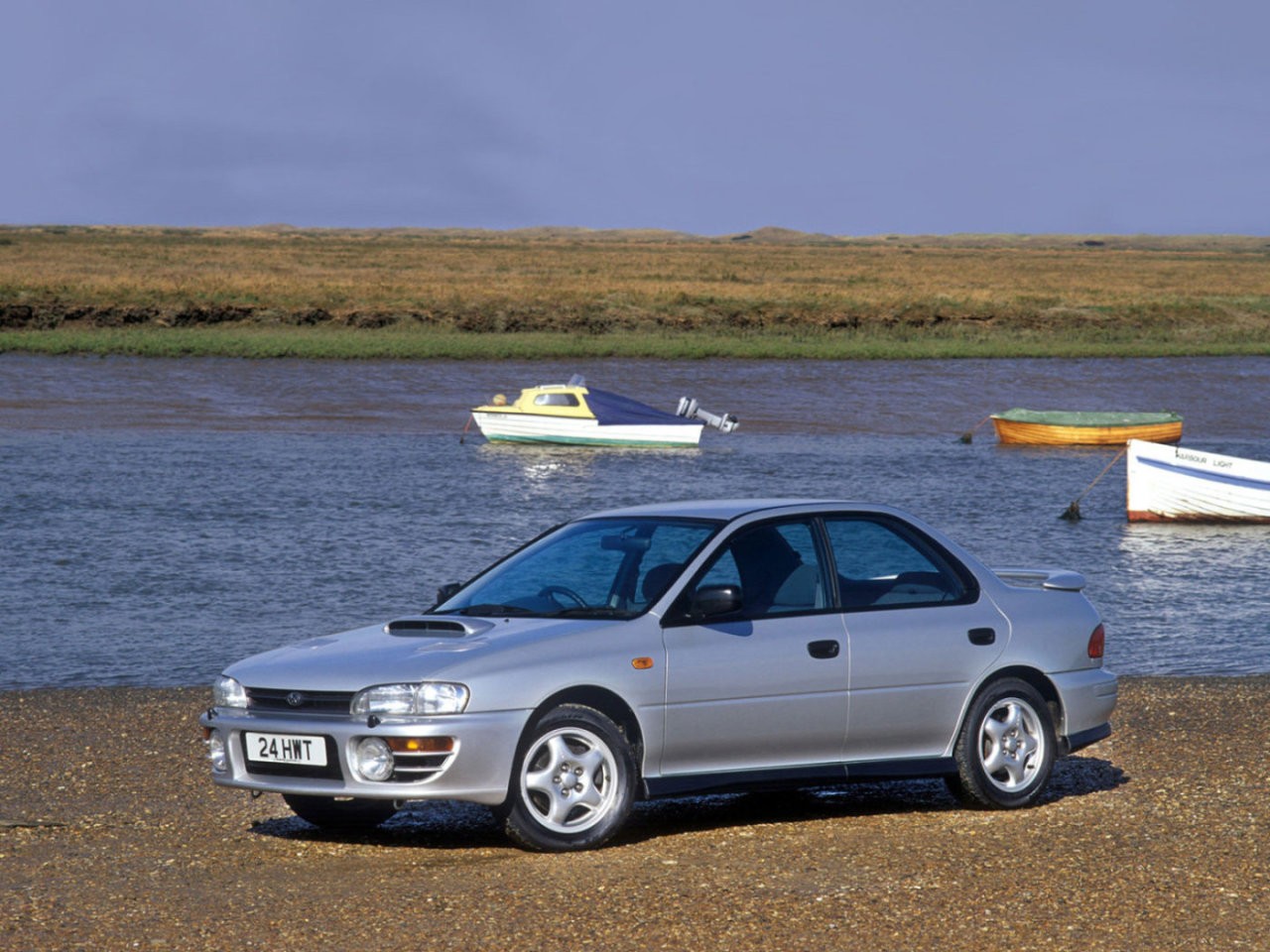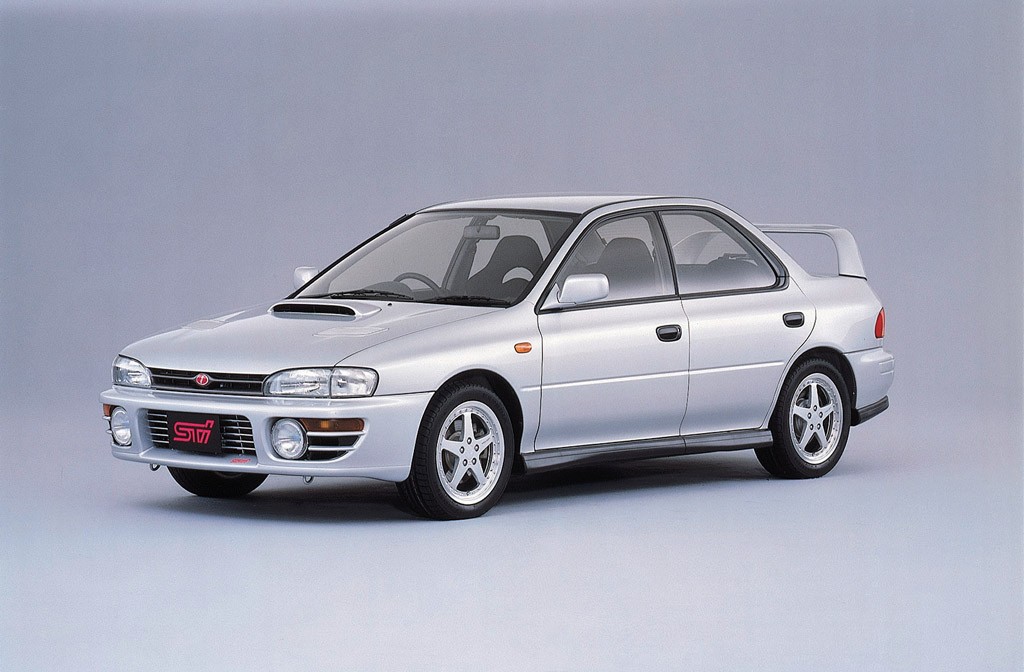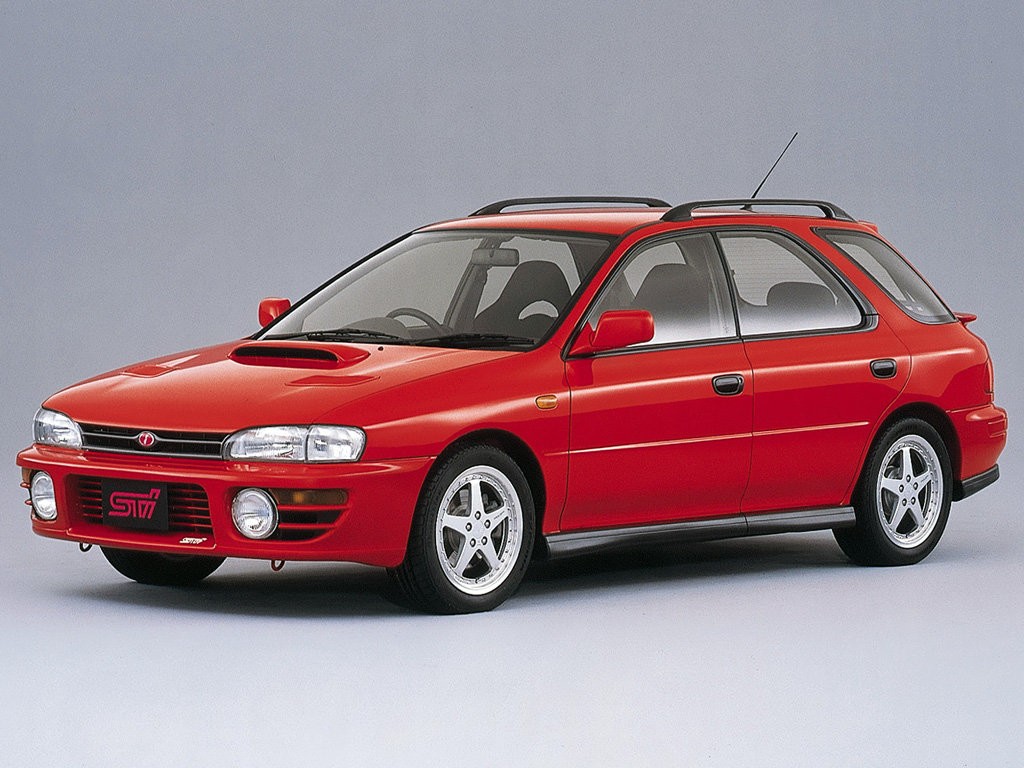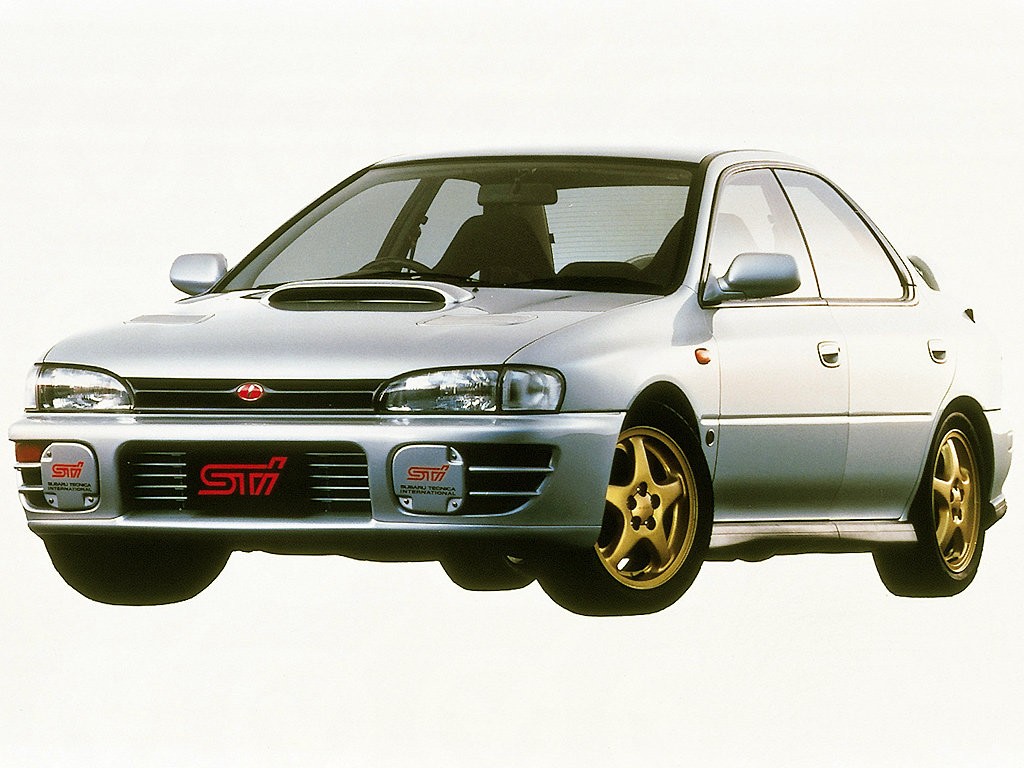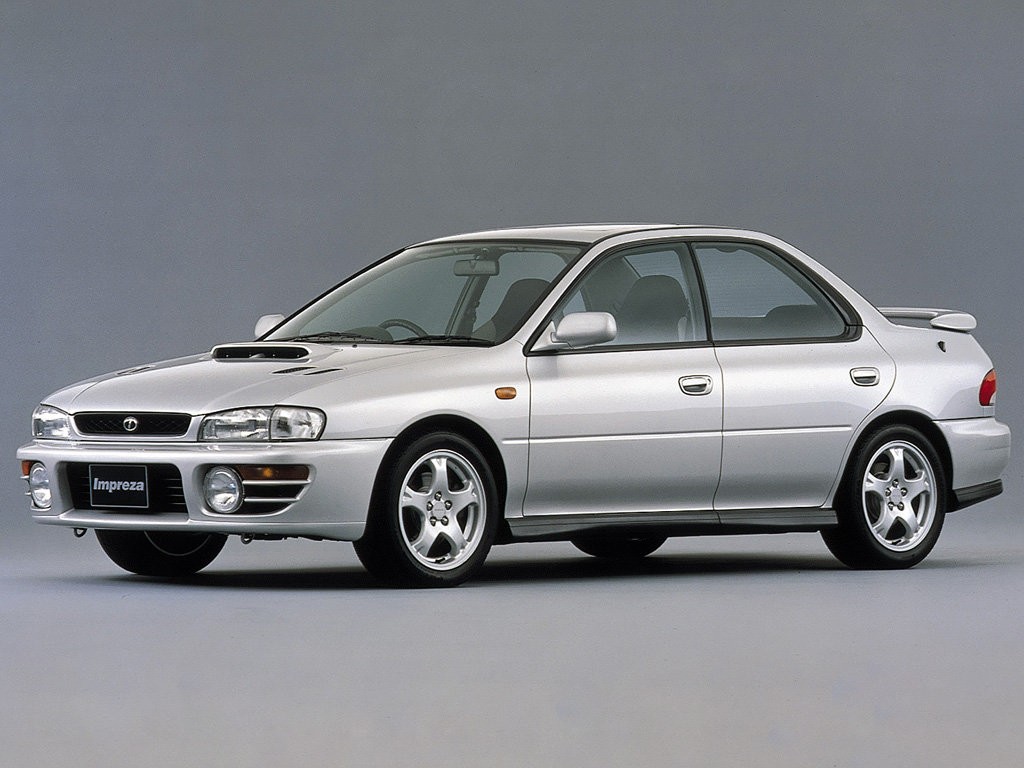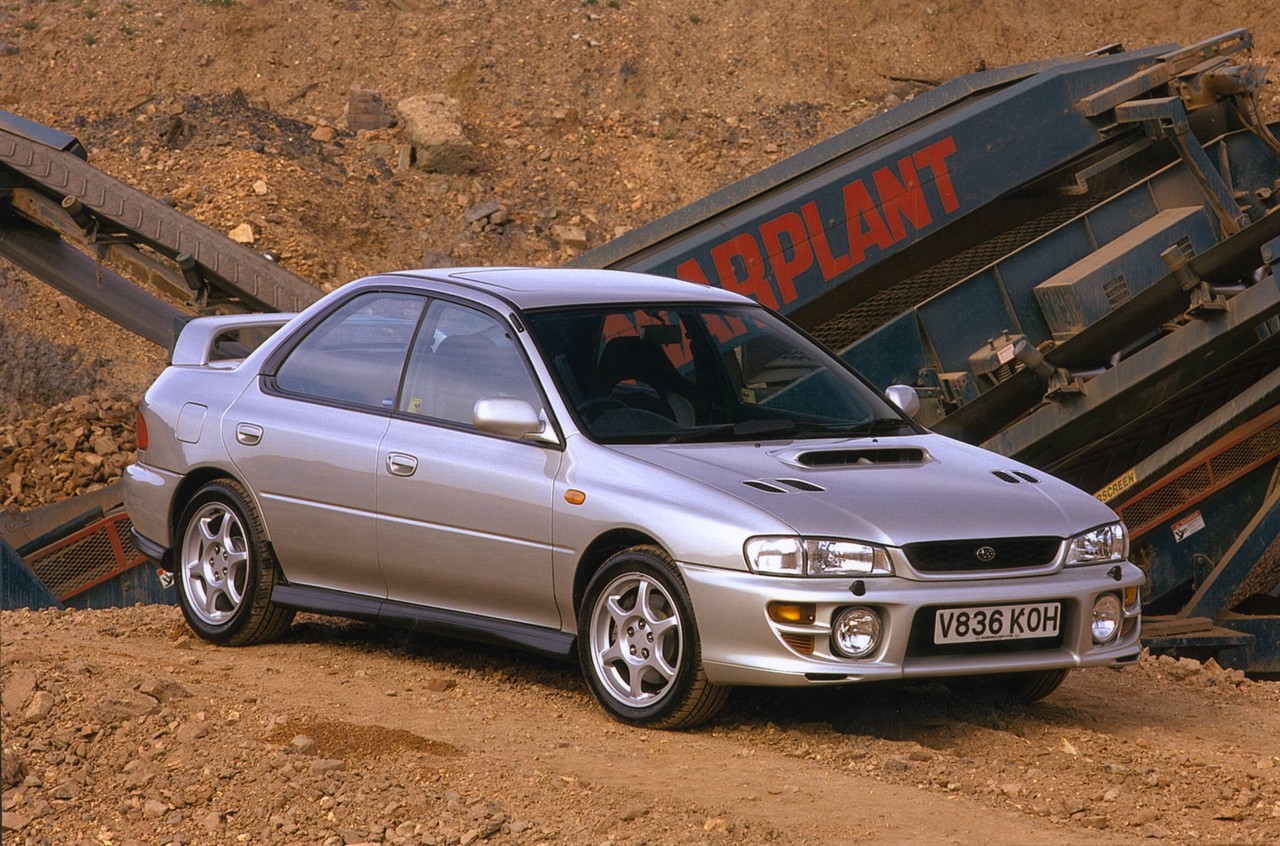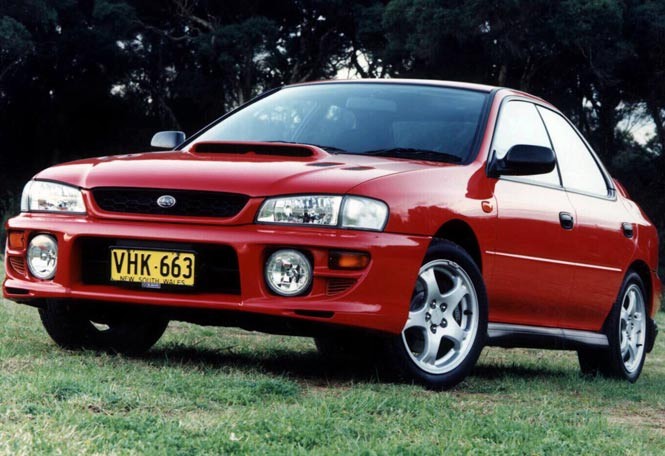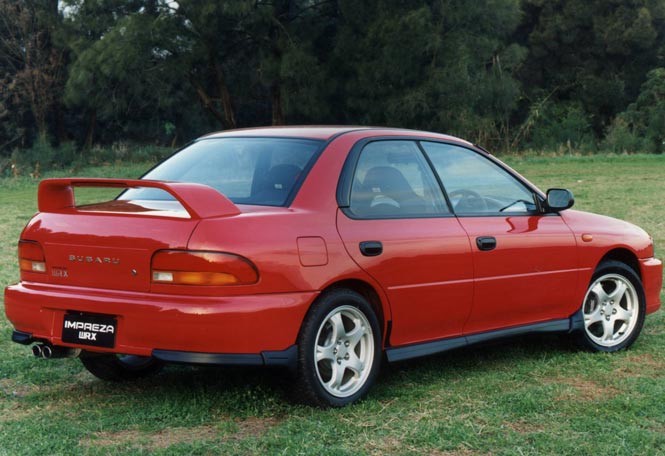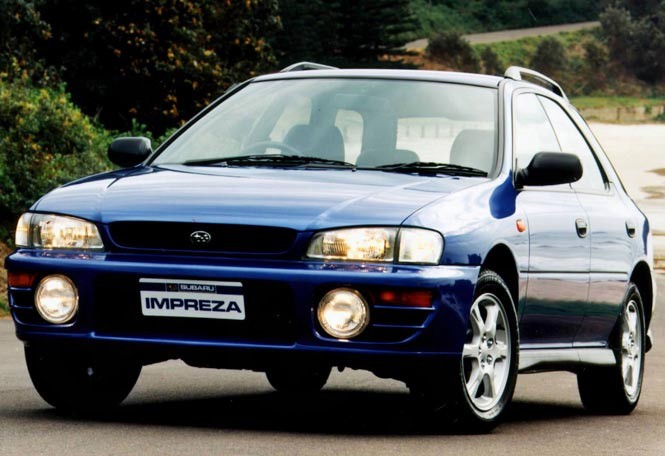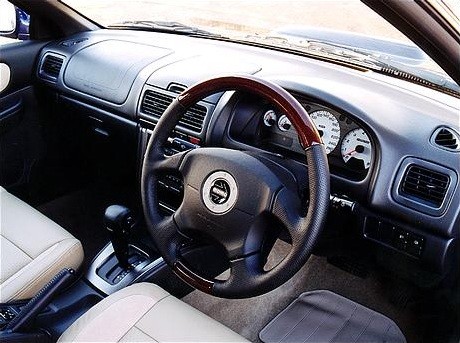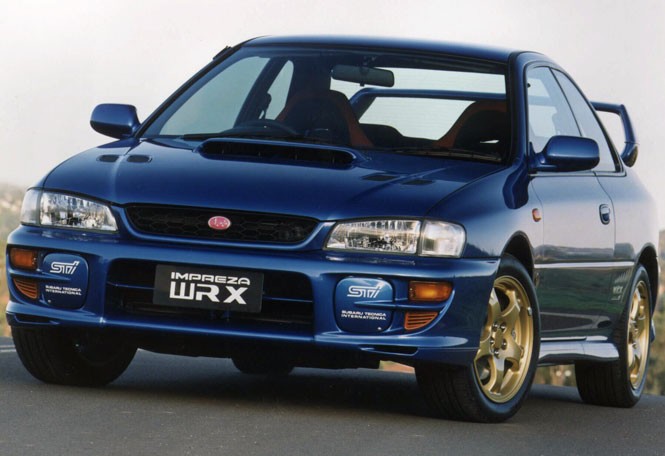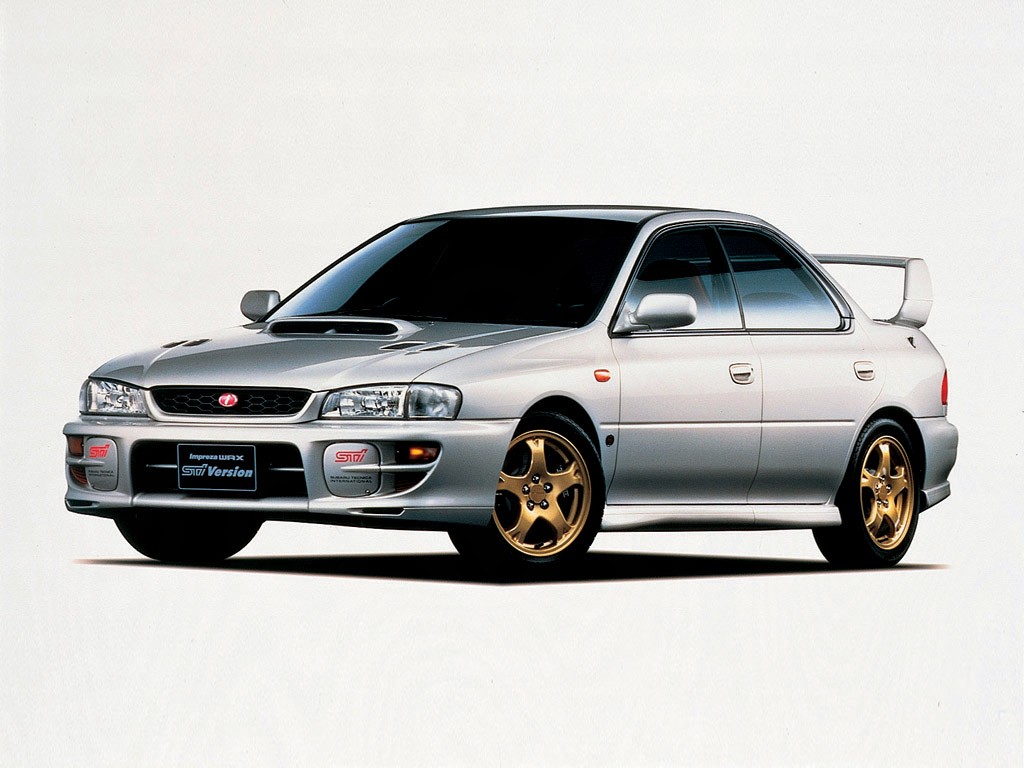
- For Impreza WRX, flexible 2.0-litre turbocharged petrol engine has only a hint of lag
- Traction from 50:50 all-wheel drive system makes for excellent dynamics
- Light body is agile and balanced
- Responsive brakes
- Turbo lag for Impreza WRX STi
- For early models, notchy manual gear shift operation
- Firm ride
- Body lacks rigidity
- Cabin lacks sound insulation
Review: Subaru GC.I/GM.I Impreza WRX (1994-96)
Overview
Released in February 1994, the Subaru GC/GM Impreza WRX (short for ‘World Rally Experimental’) was available as a four-wheel drive sedan (GC) or wagon (GM). Manufactured in Ota, Japan, the GC/GM Impreza WRX was powered by Subaru 2.0-litre EJ20G horizontally-opposed four-cylinder petrol engine; For the GC.I/GM.I Impreza WRX, a five-speed manual transmission was fitted as standard.
EJ20G engine
For the GC/GM Impreza WRX, key attributes of the EJ20G engine included its open-deck aluminium alloy cylinder block, aluminium alloy cylinder head, Mitsubishi TD05 turbocharger (understood to provide peak boost pressure of 11-12 psi), double overhead camshafts, four valves per cylinder actuated by hydraulic lifters and compression ratio of 8.0:1.
Dimensions and suspension
The GC/GM Impreza WRX was 4340 mm long, 1690 mm wide, 1400 mm tall and had a 2520 mm long wheelbase. Furthermore, the GC/GM Impreza WRX had MacPherson strut front suspension and independent rear suspension with dual links.
| Engine | Trans. | Peak power | Peak torque | |
|---|---|---|---|---|
| Impreza WRX | 2.0-litre EJ20G turbo petrol F4 | 5sp man. | 155 kW at 6000 rpm | 270 Nm at 4000-4800 rpm |
AWD system
The Impreza WRX was fitted with an all-wheel drive system which utilised a viscous coupling locking differential. In normal conditions, the system provided a 50:50 front:rear torque split. In the event that one of the wheels lost traction, however, up to 80 per cent of the engine’s torque could be directed to the opposing axle.
Safety equipment
Standard safety equipment for the Impreza WRX was limited to ABS.
Features: Impreza WRX
Standard features for the Subaru GC/GM Impreza WRX included 15-inch alloy wheels, a four speaker sound system with a radio and cassette player, air conditioning, contoured sports seats, front fog lights, split and folding rear seats, leather-wrapped steering wheel and gear knob, central locking, power mirrors, power windows, a height adjustable driver’s seat and a tilt adjustable steering wheel.
1995 Impreza WRX Rallye
In October 1995, a limited-run Rallye edition was released. Available solely as a sedan, the Rallye was distinguished by its gold-painted alloy wheels, Rally Blue paint finish and black interior trim.
Review: Subaru GC.II/GM.II Impreza WRX (1996-00)
Overview
Released in November 1996, the Subaru GC and GM Series II (GC.II/GM.II) Impreza WRX was powered by Subaru’s EJ20K engine and was available with a four-speed automatic transmission. Visually, the GC.II/GM.II Impreza WRX could be identified by redesigned headlights, grille and bigger air intake; inside, there was black and white seat trim.
In September 1998, however, the Impreza WRX’s EJ20K engine was replaced by the EJ205 ; safety equipment and features were also upgraded at this time (described below). In February 1999, the Impreza WRX STi was released.
EJ20K and EJ205 engines
Like the EJ20G engine, the EJ20K engine had an open-deck aluminium alloy cylinder block, aluminium alloy cylinder head, double overhead camshafts, four valves per cylinder and compression ratio of 8.0:1. Compared to the EJ20G, however, changes for the EJ20K engine included:
- The Mitsubishi TD04 turbocharger (replacing the larger TD05 turbo);
- A new intake manifold (with the compressor inlet tunneled below);
- Larger intercooler;
- New pistons;
- A new head gasket;
- For valve actuation, shim-adjustable solid tappets replaced hydraulic lifters;
- A new ECU and boost pressure control system; and,
- New ignition coils.
The EJ205 engine was a member of Subaru’s EJ Phase II engine family and, as such,
- had a newly designed cylinder head with ‘tumble swirl’ intake ports;
- the crankshaft thrust bearing was relocated to the rear of the crankshaft; and,
- lighter pistons with reduced piston pin offset and molybdenum coating were introduced.
GC Impreza WRX STi
For the GC Impreza WRX STi, the 2.0-litre EJ207 engine had an open-deck aluminium block, an aluminium cylinder head, double overhead camshafts (belt-driven), four valves per cylinder and a compression ratio of 8.0:1. Furthermore, the single-scroll turbocharger- understood to be an IHI VF28 turbo – provided maximum boost pressure of 113 kPa (16.4 psi).
| Years | Engine | Trans. | Peak power | Peak torque | |
|---|---|---|---|---|---|
| Impreza WRX | 1996-98 | 2.0-litre EJ20K turbo petrol F4 | 4sp auto, 5sp man. |
155 kW at 6000 rpm | 290 Nm at 4000 rpm |
| 1998-00 | 2.0-litre EJ205 turbo petrol F4 | 4sp auto, 5sp man. |
160 kW at 5600 rpm | 290 Nm at 4000 rpm | |
| Impreza WRX STi | 1999 | 2.0-litre EJ207 turbo petrol F4 | 5sp man. | 206 kW at 6500 rpm | 353 Nm at 4000 rpm |
AWD system
For Impreza WRX models with automatic transmissions, the all-wheel drive system utilised an electronically-controlled, hydraulic multi-plate transfer clutch which provided a default 80:20 front/rear torque split. Torque distribution to the rear axle, however, could be varied according to wheel slippage, throttle position and braking.
Safety equipment
Initially, standard safety equipment included ABS and models with automatic transmissions were further equipped with a driver’s airbag. From September 1998, however, dual front airbags and ABS were standard across the range.
Features: Impreza WRX and WRX STi
Standard features for the GC.II/GM.II Impreza WRX included 15-inch alloy wheels, a four speaker sound system with a radio and cassette player, contoured sports seats, front fog lights, a leather-wrapped steering wheel and gear shift knob, central locking, power windows and mirrors, a tilt adjustable steering wheel and immobiliser.
From September 1998, the Impreza WRX was fitted with 16-inch alloy wheels with lower profile tyres. From August 1999, the Impreza WRX was fitted with factory-fitted air conditioning, keyless entry, intermittent wipers and body-coloured door mirrors and handles. In August 2000, the Impreza WRX was again updated and fitted with updated alloy wheel designs and body-coloured door mirror housings and door handles.
1999 WRX STi Version V
In January 1999, the Impreza WRX STi Version V was released. Available as a two-door sedan, only 400 vehicles were imported by Subaru Australia for the Australian market. The STi variants were fitted with STi running gear, including inverted strut suspension. Compared to the Impreza WRX, the Impreza WRX ST Version V was further equipped with leather seats and an alarm. Visually, the STi variants could be identified by their gold-painted six-spoke alloy wheels.
1999 WRX STi Version VI
In October 1999, the Impreza WRX STi Version VI was released. Compared to the Version V, the four-door Version VI was further equipped with a CD player. Like the Version V, supply was limited to 400 vehicles.
1999 and 2000 Impreza WRX Special Editions
In February 1999, an Impreza WRX Special Edition was released. Compared to the standard Impreza WRX, the Special Edition added a CD player, beige leather seats, a wood/leather MOMO steering wheel and gear shift knob, metallic instrument panel finish, body-coloured door handles and mirrors and an alarm. The Special Edition was available in dark blue mica, green mica and black mica paint finishes.
In January 2000, the Impreza WRX Special Edition was released again.
1998 WRX Silver Anniversary edition
Released in 1998, the Silver Anniversary edition was solely available as a sedan and fitted with an automatic transmission. Compared to the standard WRX, the Silver anniversary edition was distinguished by its gold-painted alloy wheels, a CD player, leather seat inserts and a black metallic paint finish.
1997 WRX Club Spec
Released in March 1997, the WRX Club Spec was distinguished by its gold-painted alloy wheels, red seat highlights, blue metallic paint finish and ‘Club Spec’ decals. Production was limited to 200 vehicles.
1998 WRX Club Spec Evo 2
In May 1998, a limited-run Club Spec Evo 2 was released. Solely available with a manual transmission, the Club Spec Evo 2 could be identified by its 16-inch gold-painted alloy wheels and Rally Blue paint finish. Inside, there was a Nardi steering wheel and gearshift knob and the seats and door linings were available in red, black or grey and combined with blue ‘555’ logos.
1999 WRX Club Spec Evo 3
Released in June 1999, the Club Spec Evo 3 was based on the MY99 Impreza WRX sedan and solely available with a manual transmission. The Club Spec Evo 3 could be identified by its gold-painted alloy wheels, ‘Club Spec Evo 3’ decal and body-coloured side skirts, rear diffuser, door handles and door mirrors. Inside, there were blue Alcantara and jersey seats. Features were also extended to include remote central locking and production was limited to 150 vehicles.
2000 WRX Club Spec Evo 4
Released in March 2000, the Club Spec Evo 4 was solely available with a manual transmission. Compared to the standard WRX, Club Spec Evo 4 features were extended to include a six speaker sound system and an in-dash Clarion CD player. Visually, the Club Spec Evo 4 could be identified by its cashmere yellow paint finish, polished black alloy wheels, brushed aluminium instrument facings and ‘Evo 4’ decals. Production was limited to 300 units (250 sedans and 50 wagons) and each vehicle had a numbered plaque on its dashboard.
Related links
